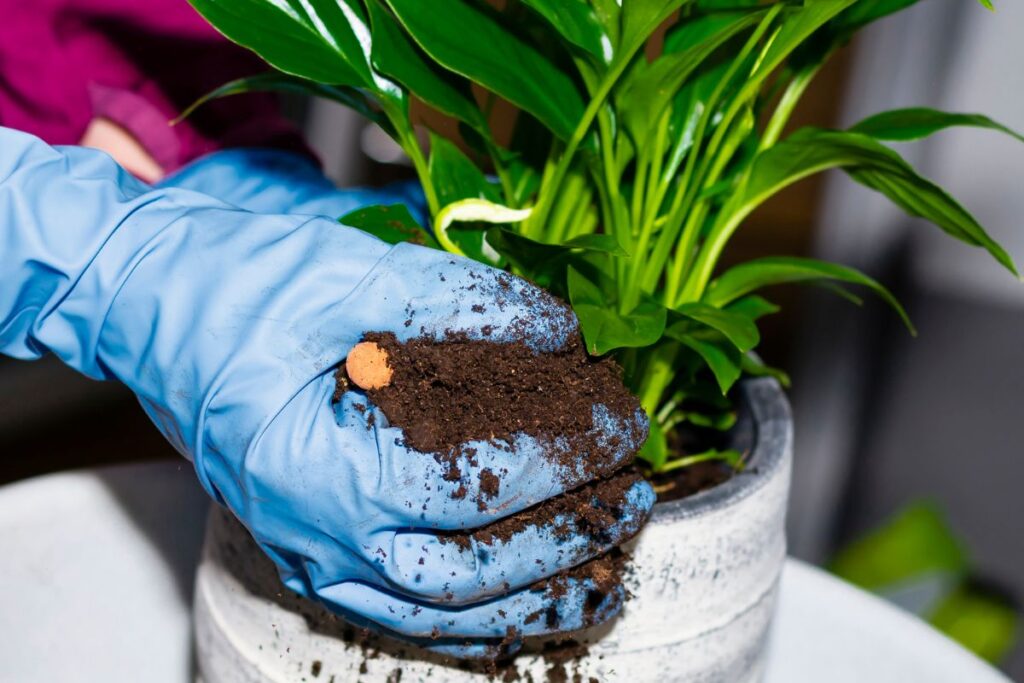Waiting for your peace lily to bloom?
It can happen with just a few simple steps!
Learn how to trigger those beautiful blooms easily.
Ready to see your peace lily flourish?
Let’s get started!
Proper Lighting Conditions

Peace lilies thrive under bright, yet indirect lighting. To prevent damage, shield them from direct sunlight, which may scorch their tender foliage. Positioning these plants near an eastward-facing aperture, complemented by gauzy drapery, is optimal. Alternatively, place them a few paces distant from a window facing south to bask in softened rays.
For indoor areas lacking natural illumination, artificial light sources are suitable substitutes. Utilize LED or fluorescent lamps, ensuring they’re positioned no further than 12 inches from your peace lily for adequate exposure. This ensures your plant receives the light it requires, even without the ideal natural conditions.
Adjust Watering Practices
Peace lily plants demand careful attention to their watering needs. They are prone to root rot when overwatered, yet they also can’t withstand prolonged dryness.
During the growing season, water once every week, ensuring that the moisture thoroughly soaks the soil. In contrast, during winter months, limit watering to bi-weekly. Always use lukewarm water to avoid shocking the plant’s roots.
Before adding water, do a simple test. Press your finger into the soil about an inch deep; if the soil feels dry, it’s time to water. If it’s moist, you’re good for another couple of days.
For best practice, water your peace lily in a location where excess water can drain without hassle, such as a sink. To maintain the glossy look of peace lily’s leaves, mist them with room temperature water once or twice weekly. This helps replicate their naturally humid environment and keeps them looking fresh.
Ensure Suitable Soil

To foster a flourishing peace lily, it is crucial to use a potting mixture that is predominantly peat-based, providing a balance of lightness and efficient drainage. Enrich the mixture with additions such as vermiculite or perlite to enhance the drainage capabilities further.
Aim for a soil pH that ranges from 5.5 to 6.5, as a mildly acidic environment is conducive to the growth of your peace lily. Utilize a potting mix specifically formulated for either tropical plants or indoor vegetation to supply the necessary nutrients for your peace lily to produce its signature, stunning white blooms.
If you opt for a general-purpose potting soil, consider providing supplementary nutrition through periodic fertilization. This will ensure that your peace lily has access to essential nutrients on a regular basis.
To maintain soil moisture, a layer of mulch can be applied to the surface. Utilize organic materials such as shredded bark or leaf mold to achieve this goal, which will contribute to a consistent moisture level and soil temperature, aiding in the health of your plant.
Use Appropriate Fertilizer
Ensuring the prosperity of your Peace lily involves providing the essential nutrients necessary for its blooms. A slow-release fertilizer with a harmonized NPK ratio, such as 8-8-8 or 10-10-10, is ideal. Opt for gentle formulas as the roots are sensitive and can be damaged by products high in salts or urea.
During the active growth periods, feeding your Peace lily is important as it rests during the colder months. When adding fertilizer, use it at half the recommended strength to prevent harm to the plant. After application, watering thoroughly is crucial to disperse the nutrients and protect the plant from nutrient burn.
Regularly flushing the soil with water to eliminate any buildup of unused minerals is a good practice. This procedure ensures the removal of potentially harmful accumulations, maintaining the health of your Peace lily throughout different seasons.
Remember, moderation and proper timing are key to fertilizing your plant effectively. By following these guidelines, you encourage a robust and vibrant Peace lily.
Choosing the Right Container
When selecting a pot for your Peace lilies, it’s crucial to ensure that it’s a size larger than the plant’s present stature. Containers crafted from plastic, ceramic, or terracotta are ideal as they enable proper drainage and air flow, vital for root health. Ensure that your chosen pot is punctuated with drainage holes at the bottom.
You need a pot that offers ample space for root expansion, both in depth and breadth. Pots with matching saucers not only enhance the visual charm but also help in controlling excess water.
Signs It’s Time for a New Pot

Struggling Peace lilies may indicate the need for a larger home. If you notice diminished growth, lack of flowering, or a wilted appearance, repotting should be considered. Choose a new pot that surpasses the current one in size to give the roots ample room to expand. Ensure the pot has drainage holes and fill it with high-grade potting mix.
After relocating your plant, place it where it can receive bright, but indirect sunlight and water it to help the soil settle. Carefully remove any limp or brown foliage and inspect the roots for decay, pruning any unhealthy parts. Proper care after repotting allows for a rejuvenated and flourishing Peace lily.
Monitor for Pests
Your Peace lily’s robust nature doesn’t make it immune to the occasional infestation by bothersome insects. Common culprits include mealybugs, spider mites, thrips, scales, and aphids.
If you notice your plant’s leaves turning colors or wilting, pests might have taken hold. Visible insects, webbing, or a sticky substance on the foliage are also clear signs of trouble.
Diseases such as powdery mildew, bacterial leaf spot, and root rot could also be compromising your Peace lily’s health, manifesting as white spots, drooping leaves, or a yellow tinge.
Regular maintenance, including wiping down leaves with a moist cloth, can go a long way in preventing these issues. Should there be any signs of disease, applications of neem oil or suitable pesticides are recommended treatments.